
As we continue to ring in 2010 we hope you enjoyed warm holidays with family and friends and celebrated the New Year with renewed hope for the future. Can you believe we’ve entered a new decade? Shall we call it 2K10, Twenty Ten, or just good old fashioned 2,010? In any case, we’re finally out of the 0’s, now we’re into the 10’s.
Our world economy has been through a lot in the past few years, yet with a promising light hovering just over the horizon. Although development overall has declined, there is continued desire for green buildings from both the public and private sector, and in general our greenroof & greenwall industry has weathered quite nicely. Many of us are taking time to reflect on this passage of time and make New Year’s resolutions (another topic altogether!), and I was thinking of how far we have come since the German experience entered our architectural radar and into our collective consciousness in the 1990’s. Literally thousands of vegetated roofs and walls have been constructed since then in every continent except for Antarctica, with ever growing support from forward thinking multidisciplinary professionals: designers, government officials, organizations, companies, universities, students and other advocates looking to make Earth a little more sustainable.
Sadly, one of those special, innovative people passed away last November 27, the indomitable architect Malcolm Wells. Regarded as “the father of modern earth-sheltered architecture,” he was a staunch advocate of living architecture, known for his way ahead-of-the-times underground earth designs with living roofs starting in the 1960’s, see just one example below. He leaves a legacy of what he referred to as gentle architecture, design that would, in his own words, “leave the land no worse than you found it.”
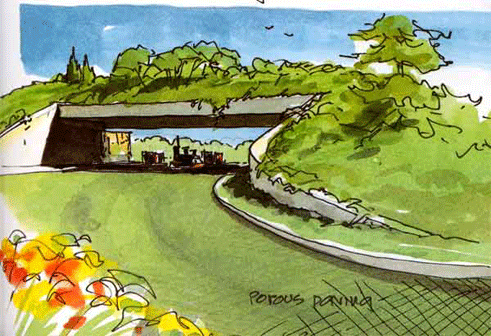
The visionary Malcolm Wells' design for an eco-gas station, from MalcolmWells.com.
Many inspirational people and organizations have contributed to our current market, and I want to highlight just a few success stories from the past year, personal and global. So in my review, here are my favorite 2009 Top 10 Milestones and Accomplishments for both Greenroofs.com as a company and our international community as a whole:
10) In 2009 Greenroofs.com celebrated 10 years of being in business! We’ve seen a lot of progress and change for the good here as well as across the greenroof world. The fledgling Greenroofs.com – “exploring the ecology of organic greenroof architecture” started out as 60+ pages in 1999 as the result of an independent research study I did at the University of Georgia.
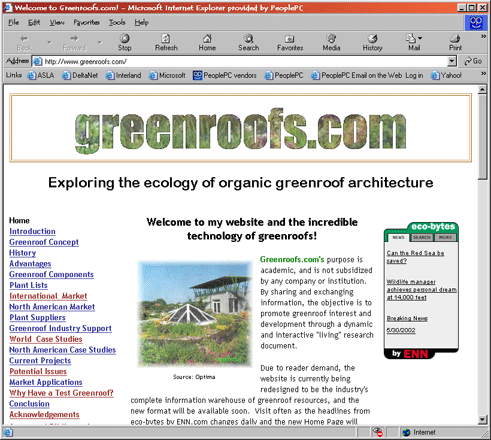
By 2003 we changed our format and grew into Greenroofs.com – “the international greenroof industry’s resource and online information portal,” and contained 600+ pages at the end of 2009 (not counting the hundreds of .php pages from The Greenroof Directory or The Greenroof Projects Database). At present, each month Greenroofs.com receives more than 160,000 unique visits and about 400,000 page views, and we’ve also expanded our presence in social marketing, too, so now you can stay connected with us on: Twitter, Facebook, LinkedIn, eNewsletter (our monthly eNewsletter consists of 10,000 opt-in subscribers) & YouTube, as well as our Blog.
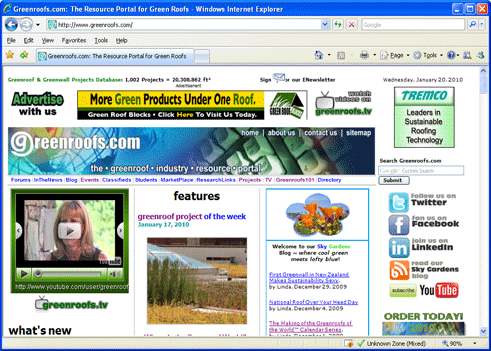
9) The proliferation of living architecture is greatly spreading and permeating into the areas of design, policy, research and education through numerous world conferences, congresses, expos, trainings, tours, and other events. For example, the World Green Infrastructure Network (WGIN) – formerly the World Green Roof Infrastructure Network (WGRIN) – held its first CitiesAlive! World Green Roof Congress in Toronto, Canada, with the second scheduled for Mexico City this October, 2010. The International Green Roof Association (IGRA) hosted the 2nd International Green Roof Congress 2009 in Nürtingen, Germany and the 3rd annual Green Roofs Australia Conference 2009 was held at the University of Melbourne. Longevity was evident with the 7th National FBB Green Roof Conference in Ditzingen, Germany and the 7th annual Green Roofs for Healthy Cities (GRHC) Greening Rooftops for Sustainable Communities Conference, Awards, and Trade Show in Atlanta, Georgia. By the way, look for the 8th annual GRHC conference to occur in Vancouver, B.C. on November 30 – December 2, 2010, rebranded as “Cities Alive.” Look for many new 2010 events throughout the U.S., Canada, Mexico, Germany, China, Singapore, India and more under Upcoming Events, where you can also access Past Events.
8) For the third year, we published our 2010 Greenroofs of the World™ Calendar. I’ve already blogged about it, and we’re very proud of our first hard product. And we thank our Sponsors for their support: American Hydrotech, Barrett Company, Conservation Technology, Express Blower, GREEN ROOF BLOCKS, GreenGrid, International Leak Detection (ILD), LiveRoof, Roofscapes, Inc., Saul Nurseries, Tremco, Xero Flor America, and ZinCo USA. You can find the Calendar on Amazon.com, but it’s a better deal if you order from us!
7) Green walls are firmly becoming entrenched in sustainable design, evidenced by high media attention, as much for their green properties as for their edible gardening possibilities. We’ve had tons of news articles posted in NewsLinks, our huge database of global articles, concerning living walls and green façades! In fact, they were listed as #31 in TIME’s 50 Best Inventions of 2009 and Triple Pundit recently proposed: “Gardens Grow Up: Are Vertical Landscapes the New Green Roofs?” – both featuring the works of Patrick Blanc. In our business you’d have to be living under a rock not to know who the renowned French botanist is; his often fantastical “murs végétalisés” designs stretch the limits of horticulture and design. Since 1994, he has created over 140 public vertical gardens as well as many private installations, including his most famous, the Quai Branly Museum in Paris, shown below. Read more about green walls from Treehugger, Daily Telegraph, Daily Commercial News, The New York Times, Times Online and CNN.com, just to name a few.
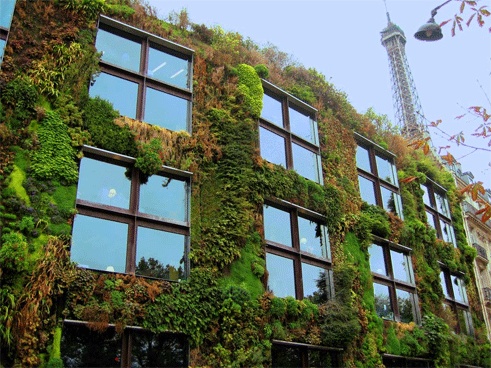
Quai Branly Museum photo courtesy and by Jean-Claude Lafarge on http://www.jeanclaudelafarge.fr/paris.html.
In 2009 Green Roofs for Healthy Cities, the North American professional association, established greenwall research projects at the British Columbia Institute of Technology and the University of Maryland, and GRHC has included an award category for Green Wall Excellence in Design for a couple of years now. In 2008 Greenroofs.com added our 8th Contributing Editor, George Irwin – aptly titled The Green Wall Editor – to cover this growing vertical gardening field, and new for 2010 we have altered the title of our Greenroof Projects Database to reflect the inclusion of these: The Greenroof & Greenwall Projects Database.
6) Investing in green building and infrastructure makes good economic sense by integrating green building policies into wider economic development goals, and creates a new job market. The American Recovery and Reinvestment Act of 2009 (ARRA) has prompted a gigantic increase in federal green spending, providing new money to all levels of government, aimed at stimulating the economy, promoting job growth, and lowering energy costs, providing an unprecedented opportunity for advancing green building and sustainability efforts in the U.S. And last December, the American Institute of Architects (AIA) reported at least 138 U.S. cities with populations over 50,000 people have green building programs in place (compared to only 92 in 2007). Referring to the economic recession, the AIA said “The downturn has had a devastating effect on construction generally, but sustainable building design continues to maintain and improve its market share.” Read their 2009 in depth study “Green Building Policy in a Changing Economic Environment” to learn more.
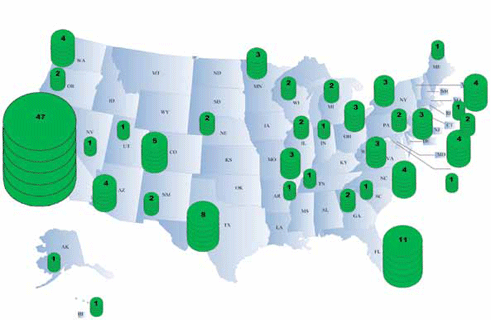
American Institute of Architects 2009 Study of Green Building Programs by Cities
U.S. economic stimulus efforts encompass green energy and construction, including greenroofs along with other forms of green building, and just one such example of Recovery Act funds benefit Washington D.C., where the Washington Business Journal says “Nearly $4 million would go toward building more than 100,000 sf of green roofs on city buildings, including libraries, firehouses and a demonstration project atop the parking garage deck at University of the District of Columbia. The stimulus funds would also expand the city’s green roof rebate program to allow residents and small businesses to afford another 20,000 sf of private green roof space.”
And importantly, many green building programs are also creating “green collar” jobs. In late 2009, the U.S. Green Building Council (USGBC) and Booz Allen Hamilton conducted a study and stated “Green building will support 7.9 million U.S. jobs and pump $554 billion into the American economy – including $396 billion in wages – over the next four years (2009-2013). The study also determined that green construction spending currently supports more than 2 million American jobs and generates more than $100 billion in gross domestic product and wages…The full report can be downloaded at www.usgbc.org/greeneconomy, where one can also find other research, resources, tools and information about green building and its role in the economic recoveries of professionals, businesses and the nation.” According to an analysis by American Rivers and the Alliance for Water Efficiency, the Natural Resources Defense Council reports that a $10 billion nationwide initiative to install greenroofs alone would result in almost 200,000 jobs – the Senate is expected to consider its own version of the bill in early 2010.
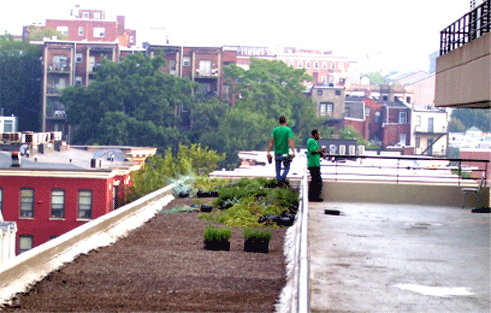
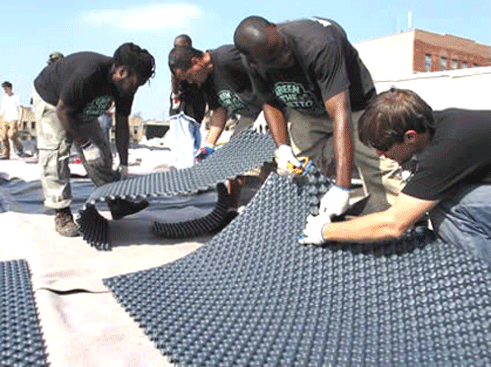
Some U.S. leaders offering hope and opportunity by creating greenroof/greenwall-specific green collar jobs through training include Sustainable South Bronx (SSBx) and their various programs, i.e., “Green the Ghetto” and “Bronx Environmental Stewardship Training (BEST)”; D.C. Greenworks; Chicagoland Green Collar Jobs Initiative, and the Urban Farming Food Chain.
5) Green Roofs for Healthy Cities launched the Green Roof Professional (GRP) accreditation for North America. The GRP is a measure of knowledge of established best practices and although a voluntary program, with the designation professionals can distinguish themselves in the marketplace. This association milestone was at least four years in the making! Currently with more than 250 GRP’s in 2009, GRHC hopes to add more professionals in 2010. Check their website for future testing dates, and consider attending one of their Green Roof Boot Camps to refresh and get you ready. See my interview with Jeff Bruce, president of Jeffrey L. Bruce & Company, Chair of GRHC and the GRHC Training and Accreditation Committee, which developed the Green Roof Professional program, to learn why the organization felt this accreditation was needed, how it evolved, and where it’s heading. For more info on the GRP, see “A Video Introduction to the GRP Program” from Green Roofs for Healthy Cities.
4) Within the U.S. industry, major contributions were made in the area to develop best practice wind and fire standards for greenroof design. Since 2007, leaders from various organizations have been working hard on prescriptive standards, and in 2009 standards were inserted into the International Building Code from members of GRHC and Single Ply Roofing Industry (SPRI). Read “Green Roof Wind & Fire Design Guidelines: After Three Years, Half the Battle is Won,” written by one of our Contributing Editors, Kelly Luckett, The Green Roof Guy, to learn about this winding road’s development of RP-14 and VF-1. And stay tuned for updates with his column here on Greenroofs.com.
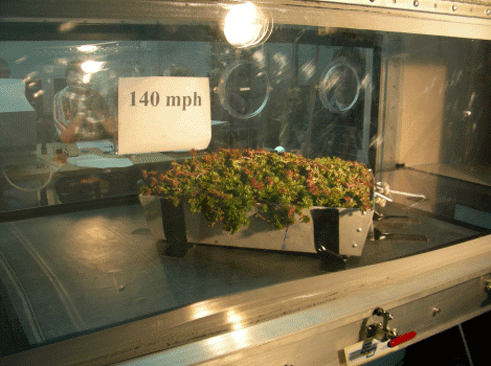
Southern Illinois University Edwardsville (SIUe) Wind Tunnel Testing in June, 2009.
3) The global Greenroof & Greenwall Projects Database surpassed the 1,000 mark in December! So where are all these greenroofs and greenwalls anyway? Let’s continue to work together to grow, update, and share valuable case studies for our communal benefit, for free. Even in today’s openly transparent society (think Google Earth), some people worry about confidentiality issues, and we only post information that is submitted to us by owners/project principals or that which is openly available through various media channels, and we always list owners as “private” when requested. The Greenroof & Greenwall Projects Database is now searchable by 24 fields, including specifically for green walls. After our Home Page, the Projects Database is the next visited page on Greenroofs.com – make sure your projects and valuable experiences are included here.
2) My albeitly biased personal favorite, Greenroofs.com inaugurated our first episode of the Sky Gardens ~ Greenroofs of the World ™ WebTV series. Premiering at Boston GreenFest in September, our new venture followed on the GreenroofsTV channel on YouTube, and next on our own greenroofs.tv, where you can now see it in its entirety at just under 37 minutes. By the way, you can also view our video offshoot, “Greenroofs 101 from Greenroofs.com” (4:50) in Greenroofs 101 or directly below, which is a great way to introduce the concept to newcomers. Coming soon is episode 2, highlighting the gorgeous Cook+Fox Architects corporate offices in Manhattan, NY. Our third episode is in the works, and more are being scheduled, so stay tuned!
1) 2009 saw some serious support for greenroofs, championed by professional organizations and governmental bodies alike. Global industry support has grown over the years, and many advocates continue to actively promote them worldwide. For example, the City of Chicago, certainly the U.S. leader in greenroofs, now has over 7 million square feet of vegetated roofs completed or under development. New support in 2009 includes:
North America: In addition to offering eco-incentives for greenroofs, currently Toronto has the most progressive policy in North America – last May Toronto became the first city here to adopt a bylaw to require and govern the construction of greenroofs. The new bylaw will be required on all new development above 2,000 m ² (about 21,530 sf) of gross floor area and have a graduated coverage requirement ranging from 20-60%. Working with a program budget of $800,000/year, owners of industrial and commercial buildings can apply for grants worth up to $100,000 (Canadian) to build a greenroof. Mayor David Miller predicts the rules and incentives will create 50 to 60 green-roofed buildings per year, in addition to their current 135 vegetated roofs. Green Roofs for Healthy Cities supported the by-law against pressure from developers opposed to the policy. See more details under Industry Support and at the City of Toronto website.
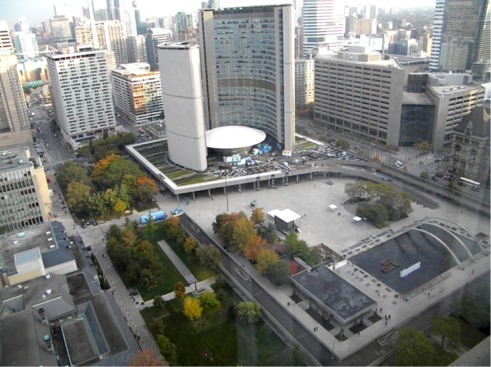
Here in the U.S., in late 2009 ASLA, the American Society of Landscape Architects, worked with Congress to include the Green Act into the House-passed climate change legislation. The Act would require the Dept. of Housing and Urban Development (HUD) to employ greenroofs, tree canopy coverage, and other site planning techniques to help reduce heating and cooling costs in certain HUD facilities. Still pending before the Senate Finance Committee, last January Senator Maria Cantwell (WA) introduced the Clean Energy Stimulus and Investment Assurance Act of 2009 (S.320), legislation geared toward creating high-wage green-collar jobs and revitalizing the economy through clean energy investments. ASLA worked with Senator Cantwell’s office to ensure that a section of the bill was dedicated to green roof tax incentives, and GRHC provided technical support. Under section 506 of the bill, residential and commercial property owners will receive a 30% tax credit for qualified greenroof expenditures.
As you may recall, Congress enacted Section 438 of the Energy Independence and Security Act of 2007 (EISA) to require federal agencies to reduce stormwater runoff from federal development projects to protect water resources and in October of 2009, President Obama signed Executive Order 13514 on “Federal Leadership in Environmental, Energy, and Economic Performance” calling upon all federal agencies to lead by example and address a wide range of environmental issues, including stormwater runoff. Federal agencies can comply with Section 438 by using a variety of green infrastructure / low impact development techniques including living roofs. Prepared by the U.S. Environmental Protection Agency in coordination with other federal agencies, the “Technical Guidance on Implementing the Stormwater Runoff Requirements for Federal Projects under Section 438 of the Energy Independence and Security Act” PDF is highly detailed and instructive.
State and municipal governments also provided policy support: Former Virginia Governor Timothy M. Kaine signed three bills promoting incentives in 2009: HB 1975 and SB 1058 authorize localities to grant regulatory flexibility and incentives to promote the construction of vegetative roofs on private homes and businesses. The incentives or regulatory flexibility could include a reduction in permit fees, a streamlined process for the approval of building permits, or a reduction in any gross receipts tax on greenroof contractors as defined by the local ordinance. The third bill, HB 1828, allows water authorities to offer rate incentives for vegetative roof construction, based on the percentage of stormwater runoff reduction. In late fall, the Ohio Environmental Protection Agency (OEPA), Metropolitan Sewer District of Greater Cincinnati (MSDGC), and the Office of Environmental Quality created a Green Roof Loan Program utilizing money from the Water Pollution Control Loan Fund. OEPA has made $5,000,000 available for linked deposit, below market rate loans to install green vegetative roofs within the service area of MSDGC on residential, commercial and/or industrial buildings.
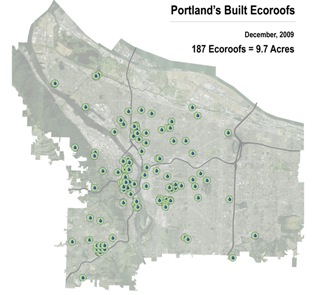
Already a city offering several greenroof incentives, in October Portland‘s city commission approved a Climate Action Plan which calls for a 40% reduction in carbon emissions by 2030 and an 80% reduction by 2050. According to the Portland Business Journal, “The Plan calls for the city and county to take 93 actions over the next three years. City bureaus must immediately begin implementing 15 of the new climate-related initiatives, such as establishing a tax credit for businesses that install ecoroofs and solar panels together.” And last month, the Milwaukee Metropolitan Sewerage District invited governments, organizations, school districts, and businesses within the 28 communities it serves to participate in their 2010 Regional Green Roof Initiative Program. Among other prerequisites, proposed projects must minimize impervious roof area and maximize the reduction in the rate and/or volume of stormwater runoff.
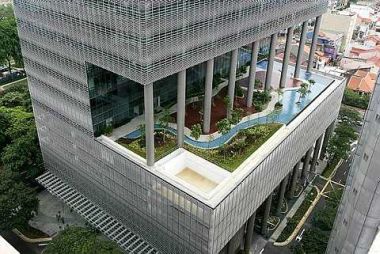
Dubai Municipality launched a greenroof initiative in line with a Dubai law on green building specifications. The Municipality’s strategic goal is to raise per capita green area to 23.4 square meters by the end of 2011, with the green building project coming under the directives of His Highness Sheikh Mohammed Bin Rashid Al Maktoum, United Arab Emirate Vice President and Prime Minister and Ruler of Dubai. A public awareness campaign for greenroofs was announced last month, committed to the “development of laws and regulations to keep pace with international standards in the field of sustainable development by planting green roofs and facades in the Emirate of Dubai.” Traveling display models and educational publications will circulate residential neighborhoods and shopping centers and markets for a 12-month period. Read more on the Dubai Municipality Portal. One spectacular greening project currently on the boards in Dubai is the self-sustained system “Food City” below, designed by Green Concepts Landscape Architects (GCLA):
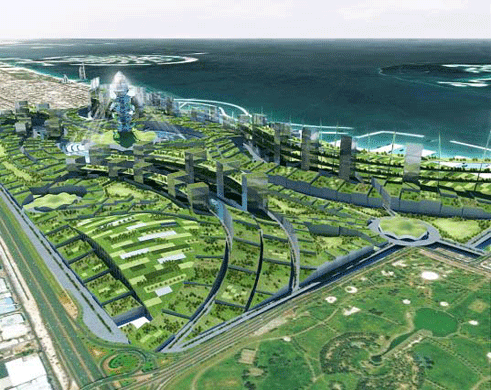
The proposed Dubai Food City, conceptualized by landscape architecture firm GCLA.
Well, those are my thoughts on the important highlights of 2009, and while on the topic of Top 10 lists, Haven Kiers – our Design Editor – and I are compiling our 4th annual Top 10 List of Hot Trends in Greenroof Designs for 2010, and we welcome your input with ideas and project example submissions, as usual! Send comments to Linda@greenroofs.com or DesignEditor@greenroofs.com.
So here we are at the start of a whole new year – we hope you’re excited and optimistic about it, just as we are! Whatever 2009 offered you, we hope you embraced new friends and opportunities and experienced great personal and professional growth, and we thank you for your readership. What’s in store for our new decade? We’ll see, but as the green building industry continues with positive signs of sustained growth, let’s also continue to collaborate and create a more sustainable world with eco-architecture embracing greenroofs and greenwalls as part of the overall green living architecture strategy.
“I woke up one day to the fact that the earth’s surface was made for living plants, not industrial plants.” ~ Malcolm Wells
Here’s a gentle toast to continued health, love, and prosperity for you, your families, and all of our greenroof associates in 2010!
Happy Greening ~ Linda V.
 Greenroofs.comConnecting the Planet + Living Architecture
Greenroofs.comConnecting the Planet + Living Architecture
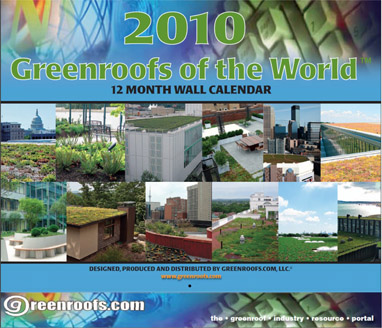

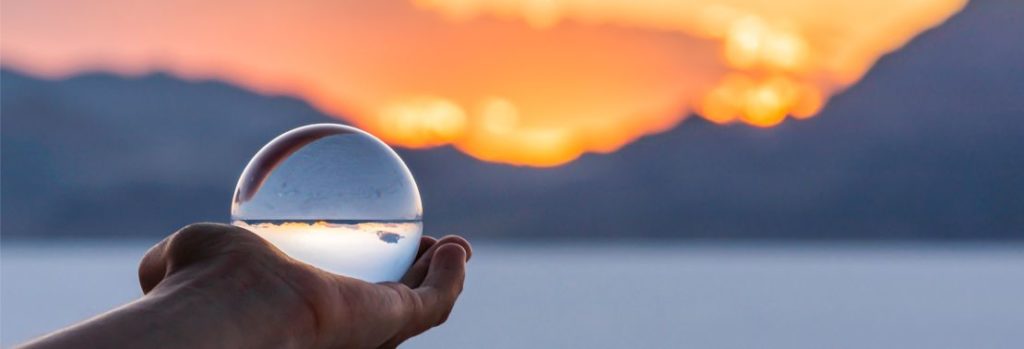

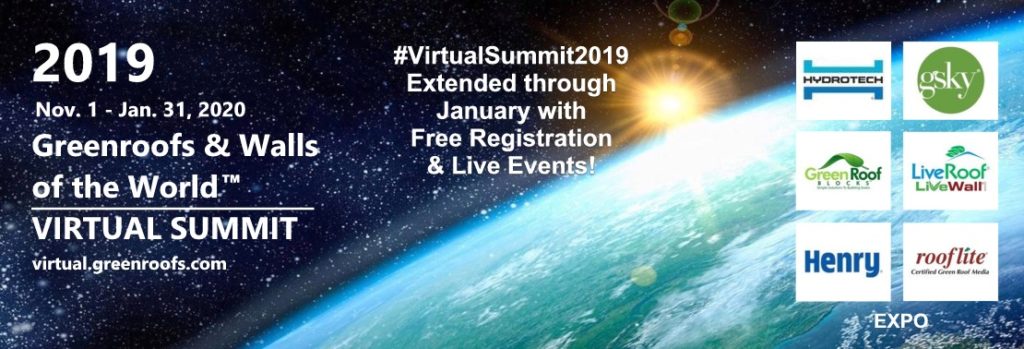
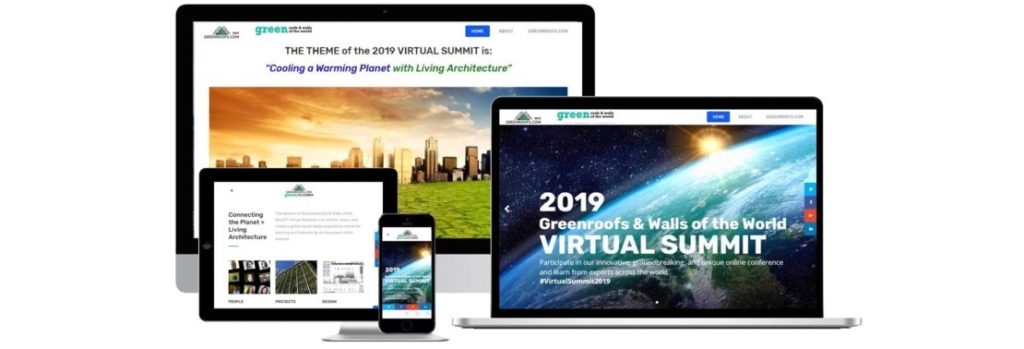




ravendell
Nice post. The proposed Dubai Food City, conceptualized by landscape architecture firm GCLA.
this is my favorite architecture